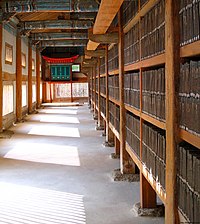
East Asian Buddhism or East Asian Mahayana is a collective term for the schools of Mahāyāna Buddhism that developed across East Asia which follow the Chinese Buddhist canon. These include the various forms of Chinese, Japanese, Korean, and Vietnamese Buddhism in East Asia.[1][2][3][4] East Asian Buddhists constitute the numerically largest body of Buddhist traditions in the world, numbering over half of the world's Buddhists.[5][6]
East Asian forms of Buddhism all derive from sinicized Buddhist schools that developed during the Han dynasty and the Song dynasty, and therefore are influenced by Chinese culture and philosophy.[7][8] The inexorable percolation of Buddhism into East Asia over a millennium[clarification needed] was due to the vibrant cultural exchanges that were made at that time as a result of trade contacts with Central and South Asia along the Silk Road. Some of the most influential traditions include Chan (Zen), Nichiren Buddhism, Pure Land, Huayan, Tiantai, and Chinese Esoteric Buddhism.[9] These schools developed new, uniquely East Asian interpretations of Buddhist texts and focused on the study of Mahayana sutras. According to Paul Williams, this emphasis on the study of the sutras contrasts with the Tibetan Buddhist attitude which sees the sutras as too difficult unless approached through the study of philosophical treatises (shastras).[10]
The texts of the Chinese Canon began to be translated in the second century and the collection continued to evolve over a period of a thousand years with the first woodblock printed edition being published in 983. The modern standard edition is the Taishō Tripiṭaka, produced in Japan between 1924 and 1932.[11]
Besides sharing a canon of scripture, the various forms of East Asian Buddhism have also adapted East Asian values and practices which were not prominent in Indian Buddhism, such as Chinese ancestor veneration and the Confucian view of filial piety.[12]
East Asian Buddhist monastics generally follow the monastic rule known as the Dharmaguptaka Vinaya.[13] One major exception is some schools of Japanese Buddhism where Buddhist clergy sometimes marry, without following the traditional monastic code or Vinaya. This developed during the Meiji Restoration, when a nationwide campaign against Buddhism forced certain Japanese Buddhist sects to change their practices.[14]
- ^ Charles Orzech (2010), Esoteric Buddhism and the Tantras in East Asia. Brill Academic Publishers, pp. 3-4.
- ^ "East Asian Buddhism and Nature (ERN) — Faculty/Staff Sites". www.uwosh.edu. Retrieved 2023-05-14.
- ^ Anderl, Christoph (2011). Zen Buddhist Rhetoric in China, Korea, and Japan. Brill Publishers. p. 85. ISBN 978-9004185562.
- ^ Jones, Charles B. (2021). Pure Land: History, Tradition, and Practice, p. xii. Shambhala Publications, ISBN 978-1611808902.
- ^ Pew Research Center, Global Religious Landscape: Buddhists.
- ^ Johnson, Todd M.; Grim, Brian J. (2013). The World's Religions in Figures: An Introduction to International Religious Demography (PDF). Hoboken, NJ: Wiley-Blackwell. p. 34. Archived from the original on 20 October 2013. Retrieved 2 September 2013.
{{cite book}}: CS1 maint: bot: original URL status unknown (link) - ^ Gethin, Rupert, The Foundations of Buddhism, OUP Oxford University Press, 1998, p. 257.
- ^ Kitagawa, Joseph (2002). The Religious Traditions of Asia : Religion, History, and Culture. Taylor & Francis Group. p. 275. ISBN 978-0700717620.
- ^ Kitagawa, Joseph (2002). The Religious Traditions of Asia : Religion, History, and Culture. Taylor & Francis Group. p. 275. ISBN 978-0700717620.
- ^ Williams, Paul, Mahayana Buddhism: The Doctrinal Foundations, Taylor & Francis, 2008, P. 129.
- ^ Gethin, Rupert, The Foundations of Buddhism, OUP Oxford, 1998, p. 258.
- ^ Harvey, Peter, An Introduction to Buddhism, Second Edition: Teachings, History and Practices (Introduction to Religion) 2nd Edition, p. 212.
- ^ Gethin, Rupert, The Foundations of Buddhism, OUP Oxford, 1998, p. 260
- ^ Jaffe, Richard (1998). "Meiji Religious Policy, Soto Zen and the Clerical Marriage Problem". Japanese Journal of Religious Studies. 24 (1–2): 46. Archived from the original on November 19, 2014.